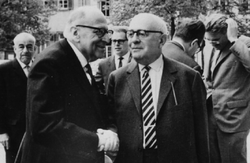Negative Dialectics
 Cover of the first edition | |
| Author | Theodor W. Adorno |
|---|---|
| Original title | Negative Dialektik |
| Translator | E. B. Ashton |
| Language | German |
| Subject | Philosophy |
| Published | 1966 (Suhrkamp Verlag) |
| Media type | |
| Pages | 416 (Routledge edition) |
| ISBN | 0-415-05221-1 (Routledge edition) |
Negative Dialectics (German: Negative Dialektik) is a 1966 book by Theodor W. Adorno.
Summary
Adorno seeks to update the philosophical process known as the dialectic, freeing it from traits previously attributed to it that he believed to be fictive. In summary, for Hegel, the dialectic was a process of realisation that things contain their own negation and through this realisation the parts are sublated into something greater. Adorno's dialectics rejected this positive element wherein the result was something greater than the parts that preceded and argued for a dialectics which produced something essentially negative. Negative Dialectics begins, "[it] is a phrase that flouts tradition. As early as Plato, dialectics meant to achieve something positive by means of negation; the thought figure of the 'negation of the negation' later became the succinct term. This book seeks to free dialectics from such affirmative traits without reducing its determinacy."[1]
Influence
Adorno's work has had a large impact on cultural criticism, particularly through Adorno's analysis of popular culture and the culture industry.[2] Adorno's account of dialectics has influenced Joel Kovel[3] and John Holloway.[4]
Further reading
- Dennis Redmond's updated translation of Negative Dialectics, with commentary.
- Buck-Morss, Susan. Origin of Negative Dialectics. Free Press, 1979.
- Jameson, Fredric. Late Marxism: Adorno or the Persistence of the Dialectic. Verso, 2007.
References
- ↑ Negative Dialectics, Theodor W. Adorno, Bloomsbury
- ↑ James Bohman (1999). Robert Audi, ed. The Cambridge Dictionary of Philosophy. Cambridge: Cambridge University Press. p. 10. ISBN 0-521-63722-8.
- ↑ Kovel, Joel (1991). History and Spirit: An Inquiry into the Philosophy of Liberation. Boston: Beacon Press. p. 261. ISBN 0-8070-2916-5.
- ↑ John Holloway. Negativity and Revolution: Adorno and Political Activism (2008) ISBN 978-0-7453-2836-2, ed. with Fernando Matamoros & Sergio Tischler
